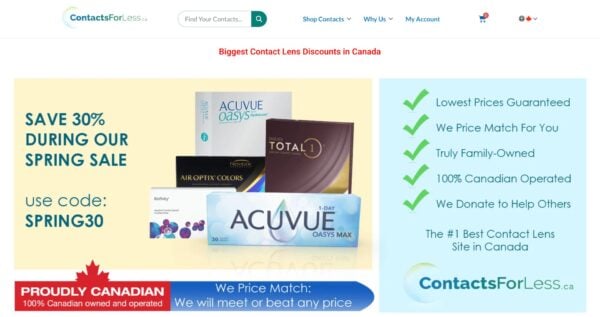
When it comes to contact lenses, the first question on most people’s minds is the cost. The answer depends on several factors, including the type of lens, brand, and where you shop, whether it is online or at your local optometrist’s clinic. If you aren’t careful, prices can add up quickly over time. That’s why it’s important to understand what you’re paying for and how to get contacts at the best value without compromising on quality or comfort. Whether you’re new to wearing contacts or just tired of overpaying, this guide will walk you through what to expect and how to keep more money in your pocket.
What Is the Average Cost of Contact Lenses?
If you’re wondering what contacts cost, the answer depends on the type of lenses you wear, your prescription needs, and where you shop. Daily lenses tend to be more expensive overall due to their frequent replacement, while monthly and bi-weekly lenses are generally more affordable over time. Specialty lenses, such as toric or multifocal contacts, come with additional costs. Here’s a quick comparison of the most common lens types to help you plan your budget.
| Lens Type | Average Cost per Box | Annual Cost Estimate | Popular Brands | Notes |
| Daily disposable contacts | $25-$50
(30 lenses) |
$600-$1,200 | Acuvue Oasys 1-Day | Most convenient and hygienic. Ideal for sensitive eyes, infrequent wearers, or those who use other prescription eyewear |
| Weekly & bi-weekly lenses | $35-$60
(6 lenses) |
$270-$450 | Acuvue 2 | Good balance between cost and convenience |
| Monthly lenses | $40-$75
(6 lenses) |
$180-$300 | Acuvue Vita | Cost-effective for regular wearers; requires cleaning and storage |
| Toric lenses (for astigmatism) | +$10-$20
per box |
Varies by base lens type | Available across many brands | Custom fit for astigmatism; higher per-box cost |
| Multifocal/
bifocal lenses |
+$15-$30 per box | Varies by base lens type | Dailies Total 1 Multi | Designed for presbyopia; adds functionality and cost |
| Colored contact lenses | $30-$60
per box |
Varies by wear frequency | Air Optix Colors | Cosmetic option, sometimes prescription, or plano |
What Factors Affect How Much Contact Lenses Cost?
 Understanding what drives the cost of contact lenses can help you make informed choices and avoid overpaying. Several factors influence how much you’ll spend — some related to your prescription and lens type, others tied to how and where you buy.
Understanding what drives the cost of contact lenses can help you make informed choices and avoid overpaying. Several factors influence how much you’ll spend — some related to your prescription and lens type, others tied to how and where you buy.
- Prescription type: Standard spherical lenses (for near or farsightedness) are usually the most affordable and are more widely available. If you have astigmatism, you’ll need toric lenses, which cost more due to their specialized design. Those with presbyopia will require multifocal or bifocal lenses, which also come at a premium.
- Brand and lens technology: High-end brands or newer technology tend to be more expensive, often because of innovations in moisture retention, oxygen permeability, or UV protection.
- Replacement schedule: The more frequently you replace your lenses, the more you’ll spend. Daily disposables are the most expensive annually but offer maximum hygiene and no maintenance. Weekly, bi-weekly, and monthly lenses are more budget-friendly, but they require specific cleaning and care products, and also require a lens cleaning solution and lens carrying cases.
- Specialty features: Lenses with additional features, such as eye-whitening tints, blue-light filters, or colored tints, may carry a higher price tag. These features are optional but can improve comfort, aesthetics, or protection.
- Where you buy them: Shopping online typically almost always results in lower prices than buying from a physical optometry office or retail store.
- Insurance and Health Spending Accounts: In Canada, private health insurance plans often cover part of the cost of contact lenses, especially if they’re prescribed for vision correction. If you have access to Canada-based supplemental insurance plans through your employer, you can use them to pay for eligible vision-related expenses like prescription lenses and eye exams. However, not all supplemental insurance will include eye care as a benefit, so check with your specific insurance company or your employer.
- Eye exam and fitting fees: While not part of the ongoing cost of lenses, eye exams and contact lens fittings are necessary expenses. These are often covered under provincial healthcare for children and seniors, but are often out-of-pocket for adults unless covered by private supplemental insurance.
- Cost of care products: If you use lenses that require daily cleaning and storage, like weekly, bi-weekly, or monthly lenses, don’t forget to account for contact lens solution, cleaning systems, and storage cases, as stated above. These can add $100 or more per year to your total cost, and for some, are more trouble than they are worth.
How Can I Save Money on Contact Lenses?
Contact lenses are a necessary but ongoing expense. The good news is that you have several options for reducing these costs without compromising your eye health or comfort. Here’s a comprehensive list of the best ways to save:
- Buy in bulk: Purchasing a 6-month or annual supply at once often unlocks volume discounts. Bulk orders also mean fewer shipments, which can reduce or eliminate shipping costs.
- Watch for manufacturer rebates: Many popular brands offer rebates when you purchase a full supply. While processing can take time, the savings are real and often stack with retailer promotions.
- Use your private health insurance or HSA: In Canada, most private insurance plans cover part of your lens cost. If you have a supplemental plan through your employer, use it to pay for lenses, exams, and care products tax-free.
- Sign up for emails and exclusive deals: Many online retailers reward newsletter subscribers with first access to coupon codes, limited-time discounts, or free shipping offers. Contacts For Less, for example, is well-known for providing some of the deepest discounts online in Canada.
- Take advantage of loyalty programs: Some retailers offer loyalty or rewards programs that give you store credit or points with every contact lens purchase, effectively turning every order into future savings.
- Compare prices across brands: Some lenses offer similar comfort and vision quality at different price points. Ask your eye care provider about lower-cost alternatives that meet your prescription needs.
- Consider switching lens types: If you’re wearing daily disposable lenses and cost is a concern, switching to weekly or monthly disposable contacts could cut your annual expense in half. Just be sure you’re comfortable with the added care steps.
- Choose bundled care kits: Retailers sometimes offer contact lens + solution bundles or “starter kits” at a reduced rate, which is especially helpful for first-time wearers. However, these options are more and more rate online, and are usually only available through your optometrist, who will charge you more, on average, for the same product.
- Avoid luxury features: Features like color tints, UV filters, or blue-light blocking can drive up the cost. If you don’t need them for medical or lifestyle reasons, stick with standard lenses.
Why Should I Order Contacts Online?
More and more people are choosing to buy their contact lenses online, and for good reason. Online retailers offer several advantages over traditional brick-and-mortar stores, particularly in terms of price, convenience, and selection. Here’s what to consider when deciding where to shop.
Lower Prices and Better Deals
Online retailers often operate with lower overhead costs, which means they can offer more competitive prices than in-store optical chains. It’s also common to find seasonal sales, discount codes, and manufacturer rebates that further reduce what contact lenses cost. Some of the very large corporate online stores only provide rebates for first-time buyers, while others, such as Contacts For Less, publicize coupons for all customers, whether they are first-time buyers or long-term customers.
Wide Selection of Lenses
Whether you wear daily disposables, bi-weekly lenses, or specialty options like toric or multifocal lenses, online stores usually carry a broader range of brands and prescription types than local retailers. This makes it easier to find exactly what your optometrist prescribed without settling for substitutions.
Convenience and Time Savings
Shopping online means you can reorder your lenses from home anytime without having to schedule visits or wait in line. Most retailers offer fast processing and home delivery, so you’ll have your lenses in hand in no time.
Free or Low-Cost Shipping
Many online contact lens retailers offer free shipping nationwide, including to rural or remote areas. Some even offer flat-rate express delivery for urgent orders.
Insurance for Lost or Damaged Lenses
Some of the online sellers also have a fee that conveniently protects you, the customer, against the possibility of theft, damage to the package during transit, or even defective lenses. This can be a very important service, considering that issues often can and do arise during shipping. This means that when an issue arises, you often pay little to nothing for a replacement.
Price Match and Transparency
Several online retailers provide price match guarantees. If you find a lower price for the same product elsewhere, they’ll match it, helping you feel confident you’re getting the best deal. But beware, since some of the online companies offer a “subscription” price that can lock you into a low price, but can be difficult to get out of, since they will automatically send lenses to you on a “schedule.”
Support for Health Benefits and HSAs
Online retailers generally issue official receipts that can be submitted to private vision insurance providers in Canada, making it easy to apply your benefits and keep your vision care budget in check.
Ethical and Sustainable Options
Some online contact lens stores also support social and environmental causes. While not universal, a growing number of companies donate a portion of their profits to charity or reduce their environmental impact through better packaging and carbon-neutral shipping options. For example, Contacts For Less is well-known for being the only company that lets the customer choose the charity where the donation is sent.
Ready to Save by Buying Your Contact Lenses Online?
When considering the cost of contacts, it’s essential to look at the whole picture, not just the price tag on a single box. The total cost depends on your prescription, lens type, how often you wear them, and where you buy them. While daily disposables offer maximum convenience, monthly and bi-weekly lenses are usually more affordable over time. Specialty lenses, such as toric or multifocal contacts, also come with added costs but offer important vision benefits.
For shoppers, buying contact lenses online can be one of the smartest ways to save money. With competitive pricing, nationwide delivery, and the ability to apply insurance benefits or use your HSA, online retailers make it easier than ever to keep your vision care budget under control.
If you’re due for a refill, consider comparing prices from Contacts for Less. We have hundreds of options, and the right choice can help you save on contacts without compromising your eye health or comfort. What’s more, Contacts For Less is a family-owned, 100% Canadian company that never outsources its call centre or processing services overseas. All staff are located right here in Canada, all the time.


 US website
US website




